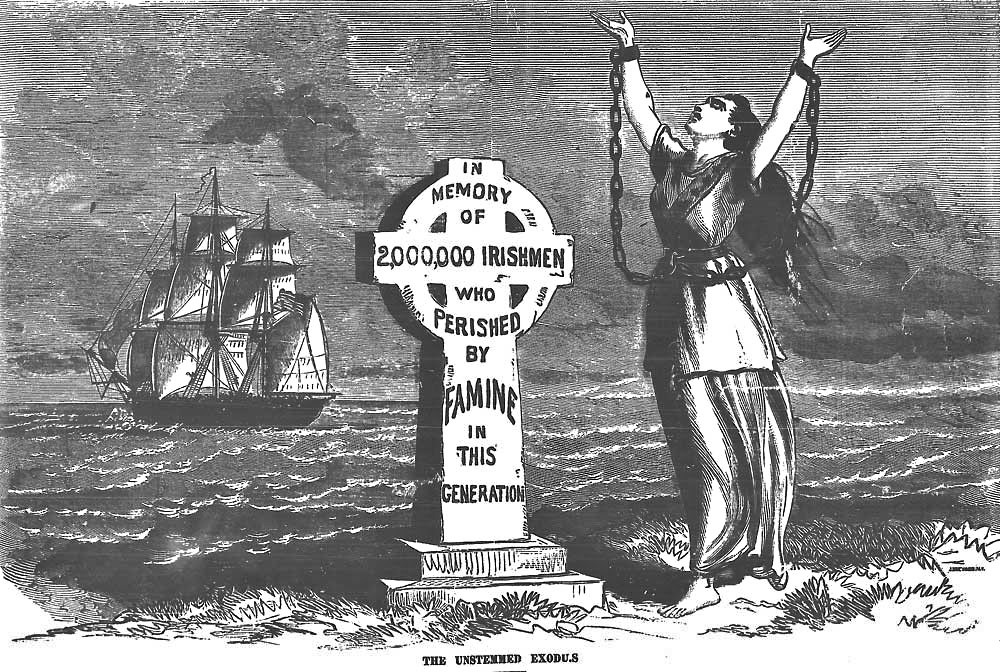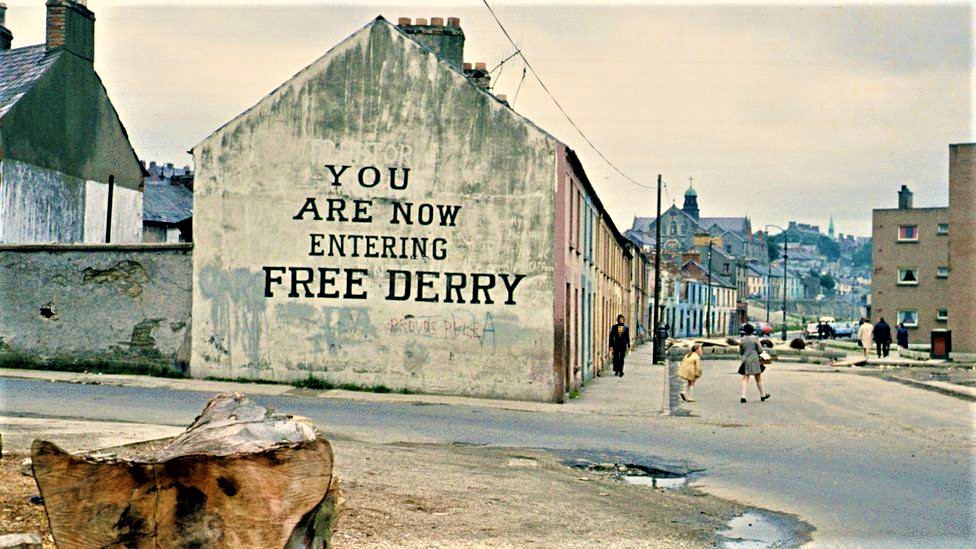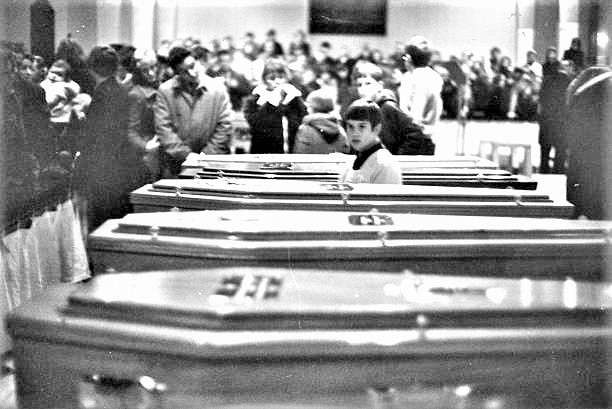Barbarism by the Epicentre of Civilisation against the Irish on “Bloody Sunday 1972” (Part 2)
TRANSCEND MEMBERS, 21 Feb 2022
Prof Hoosen Vawda – TRANSCEND Media Service
The Bloody Sunday Massacre at Lodonderry, Northern Ireland by British Soldiers
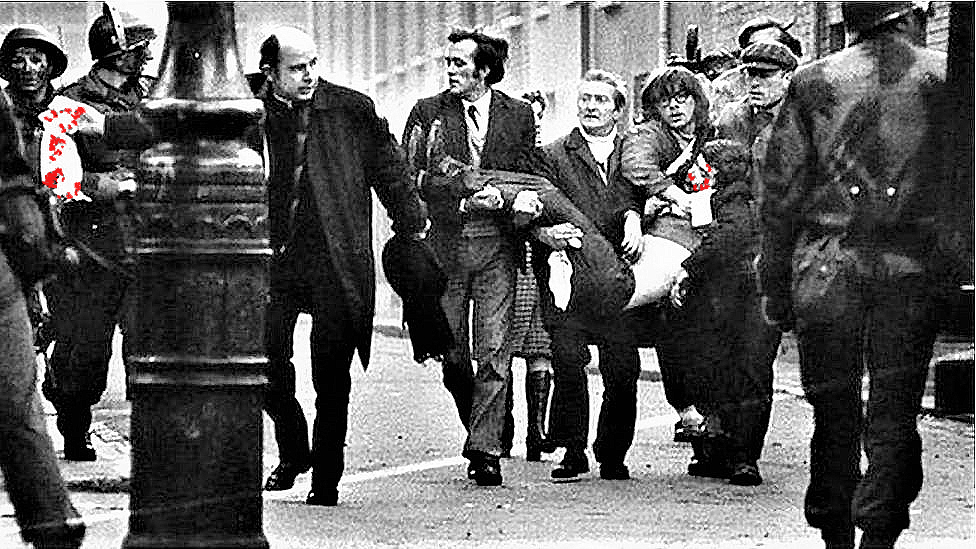
The face of British Brutality: Father Edward Daly, waving a blood-stained white handkerchief as he escorts a mortally-wounded protester to safety during the events of Bloody Sunday on 30th January 1972 in Londonderry, Northern Ireland. The young man died of his bullet wound.
Note: Blood stains digitally enhanced in red on the original photograph
He shouted: “Help! This wee boy’s dying.” and the British soldiers started clapping,[1] thunderously, at the shooting of a youth Jackie Duddy at the Bloody Sunday March, as reflected 50 years on, at the anniversary on 30th January 2022. A blood-stained handkerchief remains a powerful symbol of the struggle for Irish independence. The 17-year-old Jackie was the first of 13 people to die when the British army’s Parachute Regiment opened fire on anti-internment marchers in Londonderry’s Bogside on 30th January1972, the 14th victim of the massacre died later. The plea for assistance was the voice of the Catholic Bishop of Londonderry, Dr. Edward Daly, whose photograph becomes the hallmark of Bloody Sunday in 1972 in Ireland. He died at the age of 82 on 08th August 2016. He was the face of the iconic image, of his personal courage and bravery, in the wake of horrific brutality demonstrated by the British soldiers, who reacted violently to crush a peaceful protest of the Northern Irelanders, in seeking independence from the oppressive British Government, in Ireland. During his time in Derry, Daly takes part in the civil rights marches. He has first-hand experience of the Battle of the Bogside in 1969, the early years of the Troubles, internment, and the events of Bloody Sunday, in which British soldiers fire on unarmed protesters on 30th January1972, killing 14 people. He becomes a public figure after he is witnessed using a blood-stained handkerchief as a white flag in an attempt to escort 17-year-old Jackie Duddy, a wounded protester, to safety. Duddy dies of his injuries soon after and Daly administers the last rites. He later describes the events as “a young fella who was posing no threat to anybody being shot dead unjustifiably.”
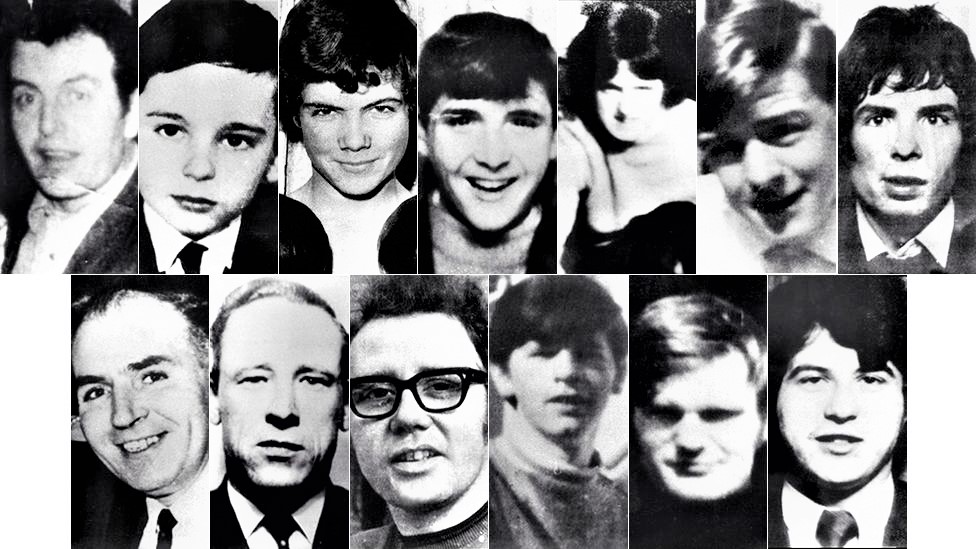
The faces of the unarmed victims of Bloody Sunday who were killed by British Soldiers on 30h January 1972. Some of the victims were shot in the back as they were running.
Daly gives an interview to the BBC in which he insists, contrary to official reports, that the protesters were unarmed. He testifies as such to the Widgery Tribunal, though he also testifies that he had seen a man with a gun on the day, to the anger of some of those involved. The Widgery Report largely exonerates the British Army, perpetuating the controversy. Years later, he says that the events of Bloody Sunday were a significant catalyst to the violence in Northern Ireland, and that the shootings served to greatly increase recruitment to the Irish Republican Army (IRA).
Prior to Bloody Sunday, Daly is sympathetic to the “old” IRA, of which his father was a member, but the events of Bloody Sunday leave him of the opinion that “violence is completely unacceptable as a means to a political end,” which leads to tension with the Provisional Irish Republican Army throughout his career.
Daly is appointed Bishop of Derry in 1974, a position he holds until he is forced to retire in October 1993 after suffering a stroke. He continues in the role of chaplain to Derry’s Foyle Hospice until February 2016. Daly dies on 08th August 2016, at Altnagelvin Area Hospital in Derry, having been admitted after a fall several weeks previously. He had also been diagnosed with cancer. He is surrounded by family and local priests.[2]
In Part 1 of this series, the author describes the senseless massacre of unarmed peaceful demonstrators in Amritsar on 13th April 1919 by a British Army General, Reginald Dyer resulting in the death of over a 1000 women, children and men.[3] The present publication highlights the similar shooting and massacre of 14 Irish people, in their quest for independence from Britain, 53 years later, in Ireland, 6696 km away from India, as the “crow flies”.[4]
The dislike of the Irish by the British is deep seated as the molten hot, core of the earth and dates back to centuries on the basis that the British always regarded the Irish as inferior to the self-styled superior British. This philosophy was used by the imperial Britain to conquer large swathes of land extending from virtually South Africa to Egypt, through to India, Burma, Thailand, China to Australia, New Zealand and across to North America, also invading the Falkland Island and the foothold of Gibraltar. In India there not only oppressed the local by instituting their famous hallmark policy of divide and rule but also plundered the country of their riches causing starvation, famine, suffering death and massacres on genocidal scale wherever they went, yet they held the high moral ground of being the centre of civilisation helping the invaded counties to become “His Master’s Voice”, converting the pagan to Christianity and “affording them protection”.
While the scope of this paper is not to delve into the early history of Ireland in the hands of British, the “Potato Famine’ of 1845[5]. Between the years of 1845 and 1852, Ireland, then part of the United Kingdom of Great Britain and Ireland, since the Acts of Union in January 1801. Executive power lay in the hands of the Lord Lieutenant of Ireland and Chief Secretary for Ireland, who were appointed by the British government. The Great Famine, also known as the Great Hunger, the Famine or the Irish Potato Famine, was a period of mass starvation and disease in Ireland from 1845 to 1852. The most severely affected areas in the west and south of Ireland, where the Irish language was dominant, the period was contemporaneously known in Irish as an “Drochshaol”, loosely translated as “the hard times”. The worst year of the period was 1847, known as “Black ’47”. During the Great Hunger, about 1 million people died and more than a million fled the country, causing the country’s population to fall by 20–25%, in some towns falling as much as 67% between 1841 and 1851. Between 1845 and 1855, no fewer than 2.1 million people left Ireland, primarily on packet ships but also steamboats and barks, known as “Coffin Ships”[6] one of the greatest mass exoduses from a single island in history, and could be classified as an ethnic genocide of the Irish engineered by the colonial British government went through an extremely oppressive and destructive period of hunger, disease, and emigration that shaped the Ireland of the future. This was an era that nobody, except the British have forgotten, and it is a sad odyssey of suffering of British subjects in Ireland. It forms the stark evidence of British tyranny, oppression and systematic genocide of the Irish people, who believed in good family values, like the subjugated Indians as a nation under the British Raj in Indian, that attacked the continent, oppressed its indigenous citizenry, plundered the natural resources and wealth of the country, and drove the people to starvation, death and finally acrimony in the form of the Partition, before the British exited Indian on 15th August 1947[7], granting it independence.. The same scenario was replicated with the pastoral, Irish people and it still continues even today. Ireland relied almost exclusively on the potato crop to provide nourishment for the population because it was affordable and relatively easy to grow in Irish soil. However, little did the farmers know that this act of vulnerability would have devastating consequences when a potato blight would hit the Country. The cause was actually an airborne fungus Phytophthora infestans, originally transported in the holds of ships traveling from North America to England. Winds from southern England carried the fungus to the countryside around Dublin. The potato blight that killed about a million people in Ireland in the 1840s originated in South America, a new genetic analysis finds. Until now, the origin of the fungus-like blight that devastated potato crops in Ireland and throughout Europe had not been pinned down.
Some members of the British government saw the Great Irish Famine as an act of God, meant to punish the Irish people and destroy Irish agriculture. Charles Trevelyan, the man responsible for organising famine relief in Ireland, believed that the famine was God’s way of punishing the Irish population. He stated: “The real evil with which we have to contend is not the physical evil of the Famine but the moral evil of the selfish, perverse and turbulent character of the people.”[8] Noting the manner in which the British government managed The Great Famine, by providing ineffective measures and continuing to export other Irish food during a time of starvation, lead to people who were already against British Rule, becoming even more resentful, as did the post-Sepoy Mutiny of 1857[9], as well as the Amritsar Massacre in India,[10] which was the catalyst for a renewed drive for independence from British, imperial tyranny.
The British Government apportioned the financial burden on Irish farmers to provide food for the starving people of greater Ireland. Subsequently, thousands of farmers and labourers were evicted from their own land, occupied by the British Lords, previously by devious means, during these challenging times because, eventually, they could not pay the levied rents. It is to be noted that by the time Ireland finally became the Irish Free State in 1921, half of its population was already abroad or had died of disease or starvation, leading to a century-long population decline.[11] Furthermore, previously between 1782 and 1783, Ireland was experiencing food shortages, as well, hence the ports were closed to constrain all Irish produce to feed their own people. However, the deep-seated acrimony against the Irish by the British, was evident during the Great Irish Famine in 1845, as ironically, the ports remained open and food exportation was actually encouraged, so that the British could generate greater financial benefits to the serious detriment of the Irish people. Furthermore, there was the Doolough tragedy[12] was another nail in the Irish coffin, during the Great Irish Famine, in Doo Lough is a freshwater lake in the west of Ireland. It is located in southwest County Mayo on the Murrisk peninsula. Here, two British officials arrived to inspect the locals who were getting a payment known as “outdoor relief”, during these challenging times. They were told to meet at a certain place, at a certain time to receive their payments. When the place was changed to another location 19 km away, people perished as they walked the journey in harsh weather conditions.[13] There is a cross and a monument in the area to commemorate this tragedy, which justifiably angered the local populace against the British. Finally, “The Poor Law” was promulgated which was a devious ploy to seize Irish land.[14] As if the socio-financial situation, was not dire enough, the British government passed a law, stating in essence that Irish property owners must support Irish poverty. Under this legislation, anyone who owned even a quarter of an acre of land was not entitled to any relief, which in turn drove people off their land. Tenant farmers began renting from British owners, and when the rents rose, they were evicted. Between 1849 and 1854, 50,000 families were evicted.
In the context of the sordid oppressive history of the Irish by British, Ireland eventually thought that after the World War 1, the British government would grant them independence as they supported the British during the Great War. Similar sentiments were expressed by the Indians in South Asia, to no avail, at the time. However, the British ensured that they utilized the divide and rule philosophy in Ireland as well as they did in secular India, where the Hindus, Sikhs and Muslims happily coexisted and the British created disunion just before the Partition in 1947. In Ireland, however the divide and rule doctrine were instigated between the Catholics in the North and the non-Catholics in the south of the country. It is also to be noted that since the time of King Henry VIII, Catholicism was banned in Britain after the execution of Sir Thomas More on 06th July 1535. because refusing to recognise Henry VIII’s divorce and the English church’s break with Rome.[15] More had opposed Henry VIII’s quest to end his marriage to Katherine of Aragon and marry Anne Boleyn, but he nevertheless accepted the position of Lord Chancellor, trusting Henry’s promise to keep him out of such matters[16]. His Holiness Pope Clement VII[17] did not annul the marriage of King Henry VIII and a purge was initiated against all Catholics in Britain. In the 20th century, the British Government used this difference to create interdenominational friction, as a parting gift to the Irish as well, where serous conflict was the order of the day by the warring forces.
However, on 30th January 2022, the 50th anniversary of the infamous Bloody Sunday Massacre, also called the Bogside Massacre[18], during a peaceful demonstration in Londonderry, abbreviated as Derry, Northern Ireland, took place on Sunday, 30th January, 1972. The Roman Catholic civil rights supporters who were unarmed were peacefully protesting and turned violent when British paratroopers opened fire, killing 13 and injuring 14 others, one of the injured died later, in hospital. Bloody Sunday precipitated an upsurge in support for the Irish Republican Army (IRA), which advocated violence against the United Kingdom to force it to withdraw from Northern Ireland. The incident remained a source of controversy for decades, with competing accounts of the events. In June 2010 the Saville Report[19], the final pronouncement of a government inquiry initiated by British Prime Minister Tony Blair in 1998, concluded that none of the victims had posed any threat to the soldiers and that their shooting was without justification. This fact was officially pronounced only 12 years later, after an investigation, which was reluctantly undertaken, in Britain. The Bloody Sunday Inquiry, also known as the Saville Inquiry or the Saville Report after its chairman, Lord Saville of Newdigate, was established in 1998 by British Prime Minister Tony Blair after campaigns for a second inquiry by families of those killed and injured in Derry on Bloody Sunday during the peak of “The Troubles”. It was published on 15th June 2010. The enquiry was set up to establish a definitive version of the events of Sunday 30th January 1972, superseding the tribunal set up under Lord Widgery that had reported on 19th April 1972,[20] 11 weeks after the events, and to resolve the accusations of a whitewash that had surrounded it, previously. The enquiry took the form of a tribunal established under the Tribunals of Inquiry (Evidence) Act 1921, and consisted of Lord Saville, William L. Hoyt, the former Chief Justice of New Brunswick and John L. Toohey, a former Justice of the High Court of Australia.[21] The judges completed hearing evidence on 23rd November 2004,[22] and reconvened once again on 16 December to listen to testimony from another witness, known as Witness X, who had been unavailable earlier.[23] The report was published on 15th June 2010. The British Prime Minister David Cameron, addressed the House of Commons that afternoon where he acknowledged, among other things:-
- That the British paratroopers had fired the first shot,
- Had fired on fleeing unarmed civilians, and
- Shot and killed one man who was already wounded.[24]
- He then apologised on behalf of the British Government.[25]
Bloody Sunday began as a peaceful, but illegal demonstration by some 10,000 people organised by the Northern Ireland Civil Rights Association in opposition to the British government’s policy of interning suspected members of the IRA without trial. The same law was applied under the Rowlatt Act[26] in India in 1919 and later in South Africa. The Anarchical and Revolutionary Crimes Act of 1919, popularly known as the Rowlatt Act, was a legislative council act passed by the Imperial Legislative Council in Delhi on 18 March 1919, indefinitely extending the emergency measures of preventive indefinite detention, incarceration without trial and judicial review enacted in the Defence of the British interests in India under the British Raj. The demonstrators marched toward Guildhall Square in the city centre, but the British army had cordoned off much of the area, prompting most of the marchers to alter their course and head toward Free Derry Corner. However, some of the demonstrators confronted the soldiers, pelting them with stones and other projectiles. British troops responded by firing rubber bullets and a water cannon. Ordered to arrest as many demonstrators as possible, the army proceeded to confront the marchers, and violence erupted. After the incident of Bloody Sunday 1972, the British embassy located on Merrion Square in Dublin was burned by the angry crowds.[27]
The Bloody Sunday Inquiry generated controversy due to its prolonged nature, mounting costs and questions regarding its relevance.[28] David Lidington, the Conservative Northern Ireland spokesman, said the costs were “scandalous”. He would be asking in Parliament why there had been such a dramatic increase. Conservative party figures said the inquiry had cost everyone in the country £6.64. The total of £400 million would have paid for [a year’s salary for] more than 15,000 nurses, nearly 5,000 doctors and 11,000 policemen, or 13 extra Apache helicopters for troops in Iraq and Afghanistan between 2001 to 2021[29], to wage another oppressive war on terror and pursuing an erroneous reporting of existence of “weapons of mass destruction” by Americans, under George W. Bush, at the time, as it now emerges.[30]
Following the publication of the Saville Report, a murder investigation was begun by the Police Service of Northern Ireland’s Legacy Investigation Branch. On 10 November 2015, a 66-year-old former member of the Parachute Regiment was arrested for questioning over the deaths of William Nash, Michael McDaid and John Young. He was released on bail shortly after.[31]
The Bottom Line is that events such as the Bloody Sunday still haunts those who were there in Derry 50 years ago and the families of the victims are still calling for justice. It is the symbol of Bloody Sunday: the white handkerchief stained red with the blood of the dying Jackie Duddy, held in the priest’s outstretched arm as he tries to bring him to safety. Colonel Derek Wilford, the highly decorated OBE, Commandant of the 1st Battalion, Parachute Regiment, is the former British Army officer in Derry, Northern Ireland on Bloody Sunday in 1972, when soldiers under his command shot 26 unarmed civilians. At the time he was a 39-year-old Lieutenant Colonel, was most arrogant and unrepentant when interviewed by Reuters[32] very much like General Dyer[33] who headed the Amritsar Massacre. According to Lord Saville, who conducted the 12-year inquiry into Bloody Sunday, the Support Company was known for “using excessive physical violence”, in combat situations.[34] Reporting on the findings of the Saville Inquiry in the House of Commons, British Prime Minister David Cameron said:-
“Mr Speaker, I am deeply patriotic. I never want to believe anything bad about our country. I never want to call into question the behaviour of our soldiers and our army, who I believe to be the finest in the world. And I have seen for myself the very difficult and dangerous circumstances in which we ask our soldiers to serve. But the conclusions of this report are absolutely clear. There is no doubt, there is nothing equivocal, there are no ambiguities. What happened on Bloody Sunday was both unjustified and unjustifiable. It was wrong.[35]
Cameron added: “you do not defend the British Army by defending the indefensible”.[36] He acknowledged that all those who died were unarmed when they were killed, and that a British soldier had fired the first shots at civilians. He also said that this was not premeditated, though “there was no point in trying to soften or equivocate” as “what happened should never, ever have happened”. Cameron then apologised on behalf of the British Government, saying he was “deeply sorry”.[37] A survey by Angus Reid Public Opinion in June 2010 found that 61 per cent of Britons and 70 per cent of Northern Irish agreed with Cameron’s apology.[38] Stephen Pollard, a solicitor representing several of the soldiers, claimed that the report had cherry-picked the evidence and did not have justification for its findings.[39]
It is to be remembered that Prime Minister David Cameron did not apologise for the Amritsar Massacre, when he had an opportunity to do so, when he visited the site of the massacre on Wednesday, 20th February, 2013[40], whereas, he officially apologized for the Bloody Sunday Massacre, to the Irish. The conclusions are obvious regarding the arrogance of the British Government, towards its subjects, be they from their former colonies.
References:
[1] https://www.irishtimes.com/culture/heritage/he-shouted-help-this-wee-boy-s-dying-the-soldiers-started-clapping-1.4777951?mode=sample&auth-failed=1&pw-origin=https%3A%2F%2Fwww.irishtimes.com%2Fculture%2Fheritage%2Fhe-shouted-help-this-wee-boy-s-dying-the-soldiers-started-clapping-1.4777951
[2] https://seamusdubhghaill.com/tag/bloody-sunday-1972/#:~:text=Daly%20dies%20on%20August%208%2C%202016%20at%20Altnagelvin%20Area%20Hospital%20in%20Derry%2C%20having%20been%20admitted%20after%20a%20fall%20several%20weeks%20previously.%20He%20had%20also%20been%20diagnosed%20with%20cancer.%20He%20is%20surrounded%20by%20family%20and%20local%20priests.
[3] https://www.transcend.org/tms/2022/02/barbarism-practised-by-the-epicentre-of-civilisation-part-1/
[4] https://www.google.com/search?q=how+far+is+londonderry+ireland+from+amritsar&rlz=1C1PNBB_enZA933ZA933&oq=how+far+is+londonderry+ireland+from+amritsar&aqs=chrome..69i57.50737j1j7&sourceid=chrome&ie=UTF-8
[5] https://en.wikipedia.org/wiki/Great_Famine_(Ireland)
[6] https://en.wikipedia.org/wiki/Coffin_ship#:~:text=A%20coffin%20ship%20%28%20Irish%3A%20long%20c%C3%B3nra%29%20was,Famine%20and%20Highlanders%20displaced%20by%20the%20Highland%20Clearances.
[7] https://www.bing.com/search?q=date+of+independence+of+india&cvid=6ae91d81ff9c4ab1bd1b2c634dc5f99a&aqs=edge.0.0.15781j0j1&pglt=43&FORM=ANSPA1&PC=U531#:~:text=Independence%20Day-,Independence%20Day%20is%20celebrated%20annually%20on%2015%20August%20as%20a%20national%20holiday%20in%20India%20commemorating,-the%20nation%27s%20independence
[8] https://www.brainyquote.com/quotes/charles_trevelyan_400732
[9] https://www.britannica.com/event/Indian-Mutiny#:~:text=Indian%20Mutiny%2C%20also%20called%20Sepoy%20Mutiny%20or%20First,it%20spread%20to%20Delhi%2C%20Agra%2C%20Kanpur%2C%20and%20Lucknow.
[10] https://www.transcend.org/tms/2022/02/barbarism-practised-by-the-epicentre-of-civilisation-part-1/
[11] https://en.wikipedia.org/wiki/Irish_Free_State
[12] https://en.wikipedia.org/wiki/Doolough_Tragedy#:~:text=The%20Doolough%20Tragedy%20is%20an%20event%20that%20took,close%20to%20Doo%20Lough%20in%20southwest%20County%20Mayo.
[13] https://thereaderwiki.com/en/Doo_Lough_(Mayo)
[14] https://www.nationalarchives.gov.uk/education/resources/1834-poor-law/
[15] https://en.wikipedia.org/wiki/Thomas_More
[16] https://blogs.bl.uk/digitisedmanuscripts/2016/07/the-execution-of-sir-thomas-more.html
[17] https://www.google.com/search?q=which+pope+did+not+annul+the+marriage+of+King+Henry&rlz=1C1PNBB_enZA933ZA933&oq=which+pope+did+not+annul+the+marriage+of+King+Henry&aqs=chrome..69i57j33i160l4.23062j0j7&sourceid=chrome&ie=UTF-8#:~:text=from%20the%20web-,Pope%20Clement%20VII,-Henry%20had%20asked
[18] Eamonn McCann (2006). The Bloody Sunday Inquiry – The Families Speak Out. London: Pluto Press. ISBN 0-7453-2510-6. pp. 4–6
[19] https://en.wikipedia.org/wiki/Bloody_Sunday_Inquiry#:~:text=The%20Bloody%20Sunday%20Inquiry%2C%20also%20known%20as%20the,the%20peak%20of%20ethno-political%20violence%20known%20as%20
[20] https://en.wikipedia.org/wiki/Bloody_Sunday_Inquiry#:~:text=%22The%20question%20of%20responsibility%20for%20the%20deaths%20and%20injuries%20on%20Bloody%20Sunday%22.%20Report%20of%20the%20Bloody%20Sunday%20Inquiry.%2015%20June%202010.%20Archived%20from%20the%20original%20on%2018%20June%202010
[21] “Questions & Answers”. Bloody Sunday Inquiry. 2010. Archived from the original on 13 March 2011.
[22] “Saville inquiry judges retire”. BBC News. 23 November 2004. Archived from the original on 11 January 2007.
[23] https://en.wikipedia.org/wiki/Bloody_Sunday_Inquiry#:~:text=%22Surprise%20return%20for%20inquiry%22.%20BBC%20News.%2016%20December%202004.%20Archived%20from%20the%20original%20on%2011%20January%202007.
[24] “Saville: Bloody Sunday killings unjustifiable”. Raidió Teilifís Éireann. 15 June 2010. Archived from the original on 16 June 2010.
[25] “Bloody Sunday report published: Key findings”. BBC News. 15 June 2010. Archived from the original on 15 June 2010.
[26] https://www.bing.com/search?q=Rowlatt+Act&aqs=edge..69i57j69i59.3721296j0j4&pglt=43&FORM=ANNTA1&PC=U531#:~:text=See%20all-,The%20Anarchical%20and%20Revolutionary%20Crimes%20Act%20of%201919%2C%20popularly%20known,incarceration%20without%20trial%20and%20judicial%20review%20enacted%20in%20the%20Defence,-…
[27] https://factfile.org/10-facts-about-bloody-sunday-1972#:~:text=After%20the%20incident%20of%20Bloody%20Sunday%201972%2C%20the%20British%20embassy%20located%20on%20Merrion%20Square%20in%20Dublin%20was%20burned%20by%20the%20angry%20crowds.
[28] https://en.wikipedia.org/wiki/Bloody_Sunday_Inquiry#:~:text=The%20Bloody%20Sunday%20Inquiry%20generated%20controversy%20due%20to%20its%20prolonged%20nature%2C%20mounting%20costs%20and%20questions%20regarding%20its%20relevance.
[29] https://www.bing.com/search?q=ahghaistan+war+on+terror&qs=n&form=QBRE&sp=-1&pq=ahghaistan+war+on+terror&sc=0-24&sk=&cvid=EC0C2927EC8547CE9761FC2FDFF8689B#:~:text=war%20on%20terror%3F-,War%20in%20Afghanistan,-(2001%E2%80%932021)
[30] https://www.wsws.org/en/articles/2003/06/wmd-j21.html
[31] “Bloody Sunday: Former British soldier released on bail”. BBC News. 11 November 2015. Archived from the original on 26 April 2019.
[32] Reuters video in March 2019: https://www.bbc.com/news/uk-northern-ireland-47559123
[33] https://janetpanic.com/what-happened-to-general-dyer-after-jallianwala-bagh/
[34] https://www.bbc.com/news/uk-northern-ireland-47559123#:~:text=According%20to%20Lord%20Saville%2C%20who%20conducted%20the%2012%20year%20inquiry%20into%20Bloody%20Sunday%2C%20Support%20Company%20was%20known%20for%20%22using%20excessive%20physical%20violence%22.
[35] https://www.bbc.com/news/10322295
[36] RTÉ News (15 June 2010). “Bloody Sunday killings ‘unjustifiable'”. Archived from the original on 16 June 2010
[37] Stratton, Allegra (15 June 2010). “David Cameron condemns Bloody Sunday killings and makes apology”. The Guardian. London. Archived from the original on 3 January 2017.
[38] Angus Reid Public Opinion (28 June 2010). “Britons and Northern Irish Welcome PM’s Apology for Bloody Sunday” (PDF). Angus Reid Public Opinion. Archived from the original (PDF) on 3 December 2011
[39] “Bloody Sunday killings ‘unjustified and unjustifiable'”. BBC News. 15 June 2010. Archived from the original on 15 June 2010.
[40] https://www.itv.com/news/2013-02-20/david-cameron-visits-site-of-amritsar-massacre
______________________________________________
 Professor G. Hoosen M. Vawda (Bsc; MBChB; PhD.Wits) is a member of the TRANSCEND Network for Peace Development Environment.
Professor G. Hoosen M. Vawda (Bsc; MBChB; PhD.Wits) is a member of the TRANSCEND Network for Peace Development Environment.
Director: Glastonbury Medical Research Centre; Community Health and Indigent Programme Services; Body Donor Foundation SA.
Principal Investigator: Multinational Clinical Trials
Consultant: Medical and General Research Ethics; Internal Medicine and Clinical Psychiatry:UKZN, Nelson R. Mandela School of Medicine
Executive Member: Inter Religious Council KZN SA
Public Liaison: Medical Misadventures
Activism: Justice for All
Email: vawda@ukzn.ac.za
Tags: British Colonialism, British empire, Europe, History, Ireland, Massacre, Northern Ireland, UK
This article originally appeared on Transcend Media Service (TMS) on 21 Feb 2022.
Anticopyright: Editorials and articles originated on TMS may be freely reprinted, disseminated, translated and used as background material, provided an acknowledgement and link to the source, TMS: Barbarism by the Epicentre of Civilisation against the Irish on “Bloody Sunday 1972” (Part 2), is included. Thank you.
If you enjoyed this article, please donate to TMS to join the growing list of TMS Supporters.

This work is licensed under a CC BY-NC 4.0 License.
